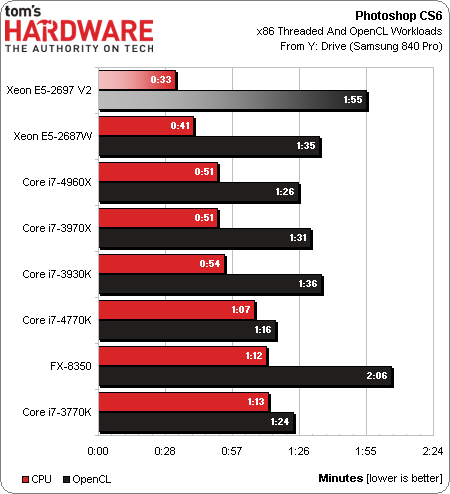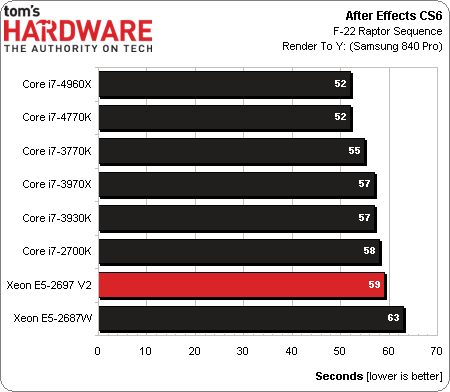Intel's 12-Core Xeon With 30 MB Of L3: The New Mac Pro's CPU?
Results: Adobe CS6
The Photoshop results are interesting, and we’re actively looking into why the results fall the way they do.
To be specific, the CPU-oriented Photoshop test that we run is well-optimized for threading, and you can clearly see performance scaling from the Ivy Bridge-based Core i7-3770K at 1:13 to the Ivy Bridge-EP-based Xeon E5-2697 V2 at :33, using eight additional cores to cut the workload time in more than half.
Our OpenCL-accelerated workload, which should leverage Nvidia’s GeForce GTX Titan, behaves less predictably. As we add processing power on the host side, performance actually gets worse. Quad-core Haswell finishes first, followed by Ivy Bridge. Ivy Bridge-E takes third with Sandy Bridge-E behind. The eight-core and 12-core Xeon E5s are trailed only by AMD’s FX-8350.
We’re working to replace our Premiere Pro workload with something more taxing. This project renders a custom sequence to H.264, but does not reward the addition of cores as much as it does maximum core clock rate. After all, the faster Ivy Bridge-E-based Core i7-4960X outmaneuvers the Xeon E5 we’re focusing on today.
In much the same way, our After Effects demonstrates sensitivity to IPC, clock rate, and available system memory per core due to the Quick Time component invoked in our workload.
Alright, so the Adobe CS 6 testing didn’t really demonstrate Intel’s upcoming Xeon E5-2697 V2 to be a big step forward compared to some of the company’s other processors with higher clock rates and lower core counts. That might sound like an issue for design professionals interested in running Adobe’s software on the upcoming Mac Pro.
However, it’s important to remember that one workload in any given application is not going to completely encapsulate that software’s performance. We know that scrubbing the Quick Time component from our After Effects test completely changes its behavior. And as Photoshop shows us, filters heavily optimized for multi-core CPUs really fly on a 12-core CPU, while those not threaded or tuned for OpenCL don’t see any benefit.
Get Tom's Hardware's best news and in-depth reviews, straight to your inbox.
-
jimmysmitty Reply11342601 said:The 32-bit build of Geekbench uses x87 code
Typo, top of page two.
Where is the typo? Do you mean the x87? That's not a typo.
This is interesting but not uncommon. The server market needs the boosts while most consumer desktop CPUs are already faster than most software can go.
Of course in 5 years a SB i5 will be no longer relevant but until then it will serve just fine. Even a x58 i7 is still a viable option for a CPU and its been out for at least 4 years. -
vmem Interesting article. Must admit though, while the Mac Pro's performance is certainly impressive, the overall pace of development in the high-end has been rather boring for the past 2 years. can't wait to see what Haswell-E can do late next year.Reply
"Regardless of whether you love or hate the “wastebasket” design, the system’s specs are very impressive for the volume of space it occupies."
And this remark touches on the core of the problem. these are a specialized, niche market of professionals who're buying this uber-expensive desktop for PRODUCTIVITY. sure it should look nice, especially in the office of a professional designer. but must it be SMALL? honestly, build a giant aluminum bookshelf if you have to. make it look elegant and artistic, maybe give people some power to customize it's looks, but ultimately give people the ability to customize the machine and buy the level of productivity they need. Apple, you've done some great things, as well as some things that I don't particularly like. but watching you kill the freedom of the small group of designers who love your products is rather sad... -
Someone Somewhere Reply11342721 said:11342601 said:The 32-bit build of Geekbench uses x87 code
Typo, top of page two.
Where is the typo? Do you mean the x87? That's not a typo.
Hmm, on a quick Wikipedia read, x87 was the instruction set used for the floating point instruction sets in the 8087 and later FP co-processors. Interesting.
Oops... sorry. -
natoco In a years time with the haswell refresh and series 9 chipset it will still make everyone yawn even if it was this year. Everything has been going into mobile since Nehalem. On the bright side, phones and tablets will start slowing down very soon once they too reach the same manufacturing node as enthusiast pc's, since the node determines the power envelope achievable, thus mobile is about to hit the same wall.Reply -
CommentariesAnd More What I expected for the Mac Pro's CPU was a different CPU optimized for the Mac Pro. Would be surprised if the temps of made by this 12Core beast keep things cool. But hey , this isn't final , right ? Lets hope for the best ( and an affordable Mac Pro :) )Reply -
PreferLinux http://www.mouser.com/ProductDetail/Intel/CM8063501288843S-R171/?qs=sGAEpiMZZMvqxsBVy5ZiuowErqth9imUwPY6%2fY0Um1w%3dReply
Guess what?
"Description: CPU - Central Processing Units Xeon E5-2697v2 12 CR 2.7GHz FCLGA2011"
"Pricing (USD)
1: $3,249.19
2: $3,127.04" -
Someone Somewhere Reply11343328 said:What I expected for the Mac Pro's CPU was a different CPU optimized for the Mac Pro. Would be surprised if the temps of made by this 12Core beast keep things cool. But hey , this isn't final , right ? Lets hope for the best ( and an affordable Mac Pro :) )
Nobody optimizes CPUs for anything. The set up costs are ridiculous. The closest you'll get is a custom config, like a chip with (for example) both multi-socket support and overclocking or something, but you'd have to show up to intel with a truck full of cash. -
Duckhunt as usual the folk running intel have become lazy and stupid and the developments in the desktop have gone down the hole. They just add some extra cache and extra threads and then act like they did something.Wow. ( at the stupidity).Reply
Instead of pushing out code or getting the rest of the industry to use more threading applications and develop it to make it more stable and useable. Nothing.
I guess when we have a third world america. You might as well go back to a decade 1368x738 with it being the most popular in 2006. Who can afford it? It the retro push backward.
-
Someone Somewhere Intel can't really do much about forcing the industry to use more threaded apps.Reply
Not their job to write code, other than drivers. They do make x86 Android though, because the drivers are pretty much hardcoded.
Do agree on the 1366x768 though. It's the same number of lines as XGA, just with a few pixels on the side. Maybe Intel should have forced a PPI measurement on Ultrabooks - that might have helped.



